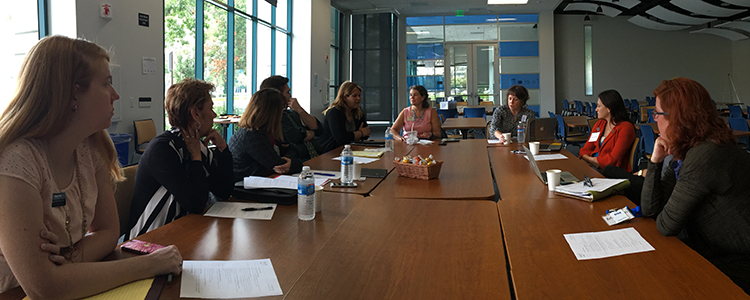Two years ago, as part of our strategic plan goal to engage with more individuals at our NAMT member theatres, we launched a new program of Management Roundtables with a forum in Miami on board development and best practices. Following the model of our successful Writers’ Roundtables and New Works Summits, this program (as the name implies) was designed to focus on topics on the business side of theatre (which may or may not overlap with new work development and production). These smaller events, hosted by our member theatres, would allow us to explore areas that we weren’t able to support a full two-day conference on, but that warranted more discussion — and more face-time — than an online presentation.
Last month we brought all of our small networking events under the single heading of Roundtables, and held our second “management” version, hosted by TheatreWorks Silicon Valley, on the topic of education. One of the key goals of our new strategic plan (which will be unveiled this fall) is to advocate for and facilitate engagement of communities, including educational initiatives, through musical theatre. This Roundtable was just one way that we’re bridging the previous plan and the new one, providing an important continuity in our mission and programs. Plus, our webinars on education-related topics have been our highest attended, suggesting that our members’ education staffs are an under-served community in our own world.
When we gathered around the (rectangular) table in Redwood City, CA, we began by sharing the top issues facing each of the education directors in the room, as well as their communities. Attendees from Seattle and Silicon Valley shared concerns about their cities’ housing bubbles causing price crunches that were restricting people’s access to the theatre (which certainly resonated with this New Yorker, too). Beyond price, could the theatre be a community resource for people who feel displaced?
On the “good problems to have” front, the other big concern was managing growth. All of our attendees — even those from large organizations or companies dedicated entirely to educational theatre — felt that they didn’t have as many resources as they wanted. At the same time, everyone had accomplished a great deal and was seeing a renewed focus on education in the industry at large. The only downside to this is maintaining expansion while your resources may stay the same.
Fortunately, we heard great stories of support from inside and outside organizations. “Programs are people,” one attendee said. We spoke of the importance of buy-in from other staff, the cast and crew on shows, and the importance of having champions. Outside the theatre too, partnerships are a two-way street. It’s important to remember that a trip to the theatre or a classroom visit by your teaching artists can be time- and energy-consuming for teachers and school administrators too; it’s not a gift you’re bestowing on them. Finding out what they need to make it easier and to make the experience as valuable as possible will make it better for everyone. Goodspeed Musicals is getting ready to do their first sensory-friendly performance. In talking to the school they’re working with, they learned that theatre training can help kids on the autism spectrum, so they’re looking at ways to continue partnering with them after the show is over. Members of the non-education staff of Red Mountain Theatre volunteer at one of their partner organizations, reading to kids to advance that group’s literacy goals. These stories were inspiring, and also highly practical!
Moving from child-focused education to a broader sense of “community engagement,” we struggled a bit to define exactly what that term means. In many ways that’s because its meaning varies depending on the theatre and how they see their own community and their relationship to it. There’s the community of the theatre itself, as well as the community — the neighborhood or city — around it. Is it part of the theatre’s mission to serve or reflect that larger community in some way? What, if anything, do you do if a segment of your community simply has no interest?
We didn’t come up with answers to a lot of these questions, but everyone agreed that it was important to break down barriers to entry, both real and perceived. Price can be an issue, of course, but also for people who have never been to the theatre, the sense of there being lots of Rules To Follow and A Way To Behave can be daunting. More importantly, the work that they’re coming to see has to be meaningful to them in some way. That programming work has to come first, and then the invitation to come see it. We spoke of the usefulness of going “narrower and deeper” — trying to cast too wide a net might end in a lot of weak results, while focused efforts could drive true engagement over a longer term. Which goes back to the importance of defining your community, your place in it, and not worrying so much about the folks who will never be engaged.
Education and marketing working together can be mutually beneficial: Even if your collaboration doesn’t translate directly into sales, is it serving your theatre’s mission? Engagement is a long game, a fact which some attendees admitted to forgetting sometimes, successfully bringing in specific segments of their communities for specific programming of interest to them, but then failing to follow up and even attempt to turn them into long-term theatre-goers. This also goes back to programming, casting and staffing — if the theatre doesn’t reflect the community, you can’t expect them to be engaged.
One thing I came away with personally, as I often do from NAMT events, was an overwhelming sense of passion and joy from our attendees. They, in turn, get the best possible feedback from the students they work with. My personal favorite: “I love your show. I like it more than pie. And I really like pie.” That’s a lot!

One student shared that she wants to tell stories for the rest of her life. Which is why most of us got into this business too. I look forward to her joining us!
You can see some of the materials from the Roundtable, including a video from our hosts at TheatreWorks Silicon Valley here. NAMT members can also listen to audio from one of the sessions there by logging in. We’ll be discussing some of these topics further at this year’s Fall Conference, so I hope you’ll join us in October!


